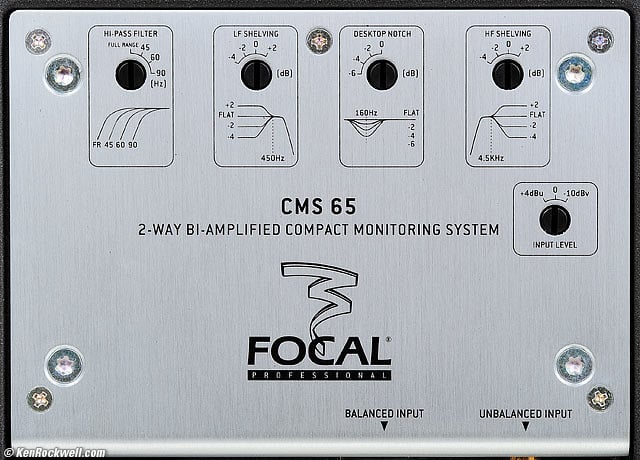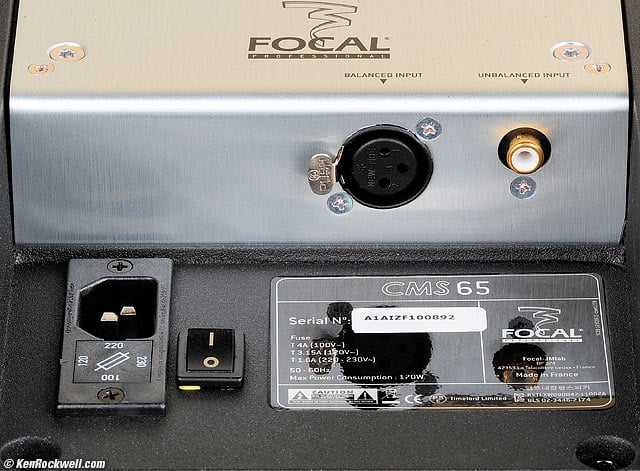Home Donate New Search Gallery Reviews How-To Books Links Workshops About Contact
Focal CMS 65
Active Nearfield Monitor (2008-)
Made in France/Fabriqué en France
© 2015 KenRockwell.com. All rights reserved.
Intro Specs Sound Measurements Compared
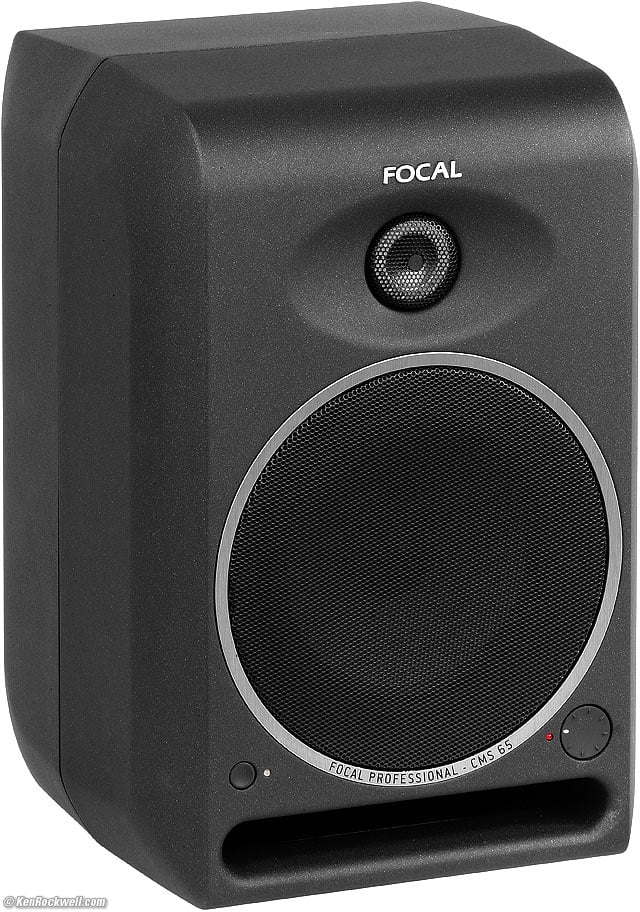
Focal CMS 65 (Solid aluminum case, 6.5" vented woofer, 1" dome tweeter, 45-28,000 Hz ± 3 dB, active 100W+60W biamplified, 108 dB SPL peak at 1m, 14.5 x 9.5 x 9.1"/369 x 241 x 231 mm HWD with base plate, 23 lbs./10.5 kg, about $800 each).
I got mine at B&H. I'd also get them at Amazon. Be sure to get two for stereo; they are sold singly.
This free website's biggest source of support is when you use those or any of these links to approved sources when you get anything, regardless of the country in which you live. It helps me keep adding to this free website when you get anything through these links — but I receive nothing for my efforts if you take the chance of buying elsewhere. Thanks for your support! Ken.
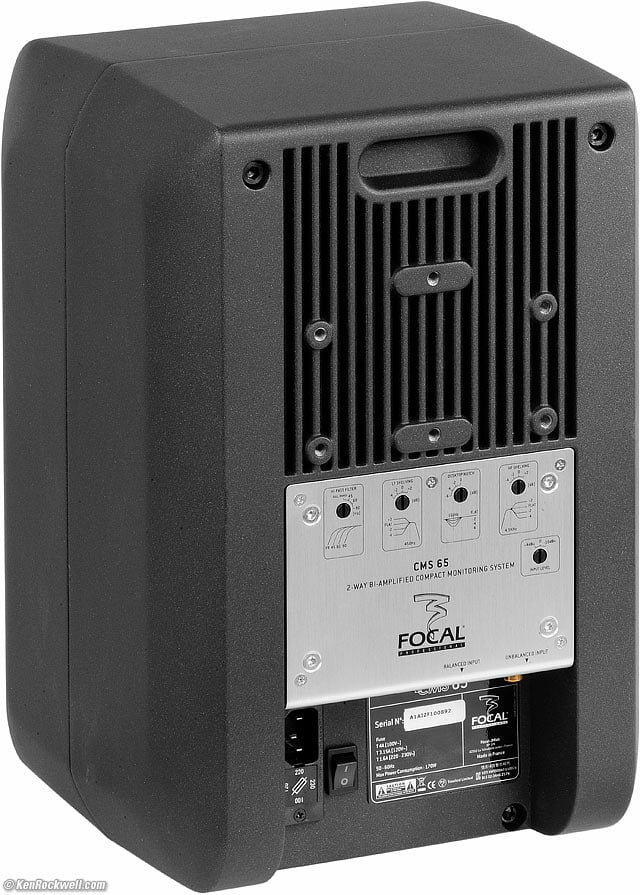
Rear, Focal CMS 65.
Controls, Focal CMS 65. enlarge.
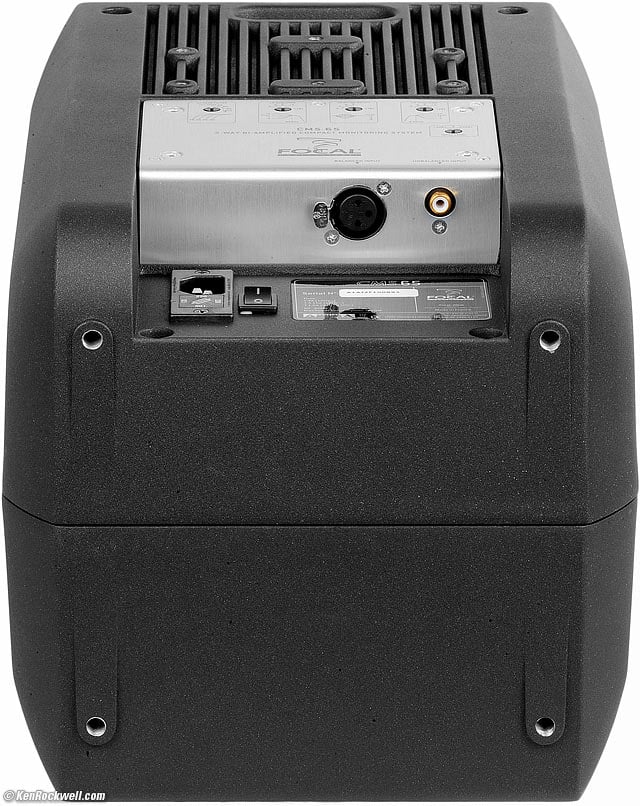
Bottom, Focal CMS 65.
Connections, Focal CMS 65. bigger.
April 2015 Focal reviews audio reviews all reviews
Introduction top
Intro Specs Sound Measurements Compared
|
Adorama pays top dollar for your used gear. I buy only from these approved sources. I can't vouch for ads below. |
The Focal CMS 65 are professional monitor speakers that also sound good enough for enjoying Hi-Fi music.
These are active monitors, with two internal amplifiers and a low-level crossover. Plug each into the wall for power and run your audio cable, and you're done: no power amplifiers needed.
They run with balanced XLR inputs as I used them, as well as with RCA inputs for consumer use. These come with adjustable screws on the bottom and rubber pads on which to sit so they work on a delicate desk without damage, and can be adjusted for precise placement. I use these at arm's length at about 120º on the front left and front right of my desk. I had to put a book under the front of each to get it to angle-up enough.
I run these from my Benchmark DAC1 HDR, and since they are self-amplified, it's just as easy to run them directly connected to an iPod or AirPort Express or any source, pro or consumer.
While they aren't quite as accurate for laboratory use as the Neumann KH 120 A, they sound many times better for enjoying music on your desktop. They are also much bigger and more powerful than the Neumann. These little speakers are very heavy, with solid aluminum cases and class AB amplifiers.
Focal recommends burning these in before use, so I burnt them in with noise at 90 dBC SPL @ 1m for 42 hours before I listened to them at all. I boosted the bass of the noise with an equalizer so the woofer cones were wiggling quite a bit this whole time.
After hooking them up after burn-in I started listening to Bizet's Symphony in C, and it sounded so good I couldn't turn it off to run my usual sweeps to set up. Their broad and especially deep soundstage wouldn't let me go; they let me hear deep into the orchestra.
These sound good even with my ears above the tweeters. Focal recommends aligning them so that your ears are directly in line with the tweeters, and I heard very little difference with height, which is excellent.
Also impressive is how their electronically-fortified bass response really does extend to the deepest E of a standard-tuned bass when used on a desk. Their bass response is good enough to let most users skip subwoofers. Also quite good is the surprisingly low levels of bass distortion, so adding external equalization to boost the deepest bass works very well to eliminate the need for subwoofers for many people. I used a Rane SP-15 and set its lowest band on SHELF, 65 Hz, and boosted +12 dB, and it sounds good enough that I didn't bother to use my subwoofers.
For enjoying music, I found they were a little too bright; bringing the octave around 6 kHz down a few dB with an external parametric EQ made them much more pleasant for most music — although as my tests show, they do have flat response.
These aren't cost-conscious consumer monitors like KRK, M-Audio or Mackie. These are first and foremost professional monitors for serious work, trying to show you exactly what you've got. Most recorded music and microphones boost the upper midrange a little bit to make it sound a little brighter than live; when playing music recorded with flat instrumentation microphones like the Telarc recordings, there's no need to dip the upper midrange for enjoying music.
Focal suggests removing the grills for the best sound. I tried them both ways and didn't hear much difference. Ultimately I don't like people poking-in my drivers, so I wound up putting the grills back on. The woofer and tweeter grills are separate, so you can use one without the other. They pull off using the little tool included; when removing the tweeter grill be sure to pop in the included plastic phase plug instead.
The turn-on delay is 1.6 seconds. Disconcerting is that there is a pop or click each time they unmute, be it during power-on, or pressing the mute switch a second time.
There is a mute/unmute button on the front lower left. Its LED is bright red when first turned-on or muted, and calm green when ready. If pink noise is your thing, you'll hear the woofers mute and unmute first by a small fraction of a second.
There is a level control on the front lower right. It's an 11-step clicked (0-10) level control. Its red LED lights when clipping.
The back panel EQ and level controls and markings are illegible in most dark studio conditions, with tiny lettering on chrome and black slots in black recessed shafts. You'll need a flashlight and a screwdriver to see and adjust them.
The dark finish uses sparkly paint. Since it's over solid aluminum, it's much nicer than similar paint used over plastic by the cheap Sigma lenses used by some photo hobbyists.
Specifications top
Intro Specs Sound Measurements Compared
Cabinet
Solid aluminum cabinet.
Woofer
6.5" vented woofer.
Cone covered with tiny glass beads, like a reflective street sign.
While called 6.5," the outside of the half-roll rubber surround measures only 5.5" and the effective piston diameter (the middle of the suspension roll) is only 5-1/16" or 130mm.
Tweeter
1" inverted metal dome.
Audio
45 ~ 28,000 Hz ± 3 dB.
100W + 60W class AB amplifiers. They aren't that fancy; a TDA7293 is used as the basis for the low-frequency section.
108 dB SPL peak at 1 m.
0.4 ~ 3 meters suggested listening distance.
Included
Speaker with grills attached.
Power cord.
Manual en français et anglais.
Bag with little grill puller-outer tool and two plastic tweeter plugs. You need only one tweeter plug; Focal includes a spare just in case.
Size
14.5 x 9.5 x 9.1" HWD with base plate.
369 x 241 x 231 mm HWD with base plate.
Weight
23 lbs. (10.5 kg).
Quality
Made in France.
Fabriqué en France.
Hecho en francia.
Warranty
2 years, even under heavy professional use.
Sound top
Intro Specs Sound Measurements Usage Recommendations More
Overall
A monitor is supposed to let you hear everything good or bad, and these do exactly that. It's easy to hear page turns and seat creeks.
These give the honest, mostly unsweetened facts about what you're putting down with loads of detail.
For Hi-Fi use on my desk, I usually have to dip the upper midrange a couple of dB to take off their edge for enjoying recorded music. Otherwise, these are also very good for Hi-Fi speakers, better than other pro monitors, with a deep soundstage, loads of detail and a reasonably sweet presentation.
Unlike many pro monitors, these don't sound boxy or papery like the Neumann KH 120. These Focal are good enough to make most music sound good, which may or may not be your intention.
The only bad thing is even though these use class AB amplifiers, there is audible hiss if you hold your ears close, and even weirder is that these hum! Yip, get within about a foot and you can hear the hum. Someone must have had to have worked hard to get the amplifiers this messed up, but at arms length it's not a problem.
Bass
As active monitors should do, the bass is electronically fortified so that these little speakers have over an octave more bass (45 Hz versus 100 Hz actual -3 dB cutoff) than passive monitors this size.
It sucks up bass and deals it out with very little distortion, so I boost the deeper bass with an external EQ and it goes even deeper. These are quite happy reproducing a 16-foot pedal C at 32 Hz with very little distortion! As you'll see confirmed in my distortion measurements, these have about the same distortion at 90 dB at one meter and 40 Hz as a 1 kW 15" subwoofer, which is superb.
Bass violins sound swell, and even huge symphonic bass drums are half there without any external equalisation.
If this were the 1950s, these would be considered full range and outperform the huge multi-box systems of that era; they would have astonished men as if these had just arrived from Mars.
Stereo Imaging
I prefer to run my monitors at the front edge of my desk separated by 110º ~ 120º for a wide image, not run them on the far side of my desk at only 60º as most people do. I'm used to sitting in the ensemble, so I prefer a wide image, but I'm also tough on needing precisely matched monitors to ensure a LASER-sharp center image.
These two random samples have a swell center image when run as wide as I run them.
Measurements top
Intro Specs Sound Measurements Compared
These are real 545-point stepped-sine anechoic measurements made with an advanced, factory-calibrated Rohde & Schwarz UPL laboratory analyzer.
These are not averaged, not smoothed, not summed nearfield-farfield, not noise-based and there is no other foolishness as seen in consumer publications.
These are real sine wave measurements. If I used any kind of smoothing these would look much better; these measurements show everything.
Frequency Response
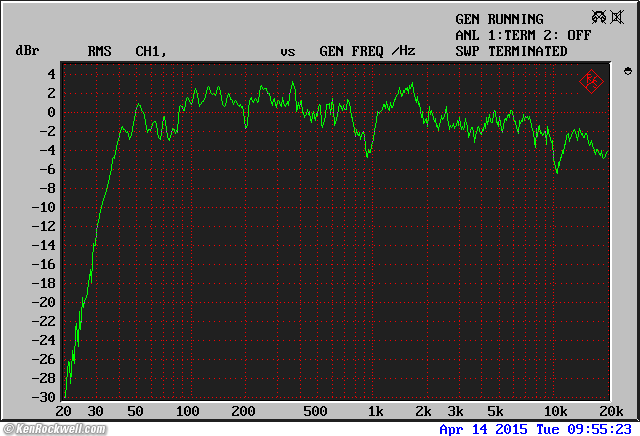
Focal CMS 65 Frequency Response.
Frequency response is excellent, but not as flat as the Neumann KH 120 A. I confirmed the slight dip at 1 kHz with more measurements not shown; this is most likely caused by undamped internal reflections from something. These are not empty boxes like passive speakers; they are crammed with amplifiers and transformers, and the woofer frames themselves can cause these reflections and dips.
I was impressed that response didn't vary with distance.
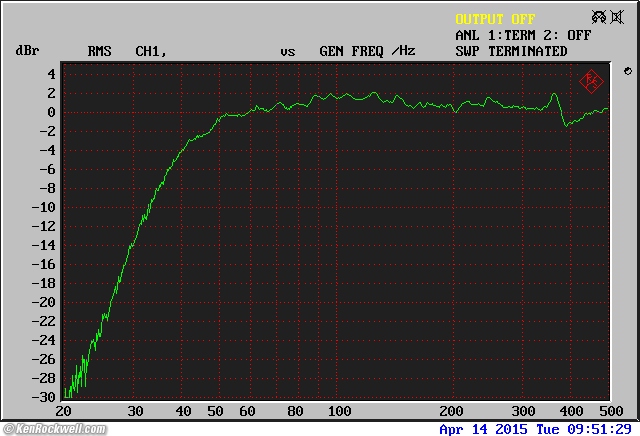
Focal CMS 65 Bass Response.
Bass response is predictable. It falls off at about 28 dB/octave below 45 Hz.
Distortion
In these graphs, the SPL refers to the general SPL; the response falls off at the lowest frequencies and is of course less than the nominal SPL for each curve.
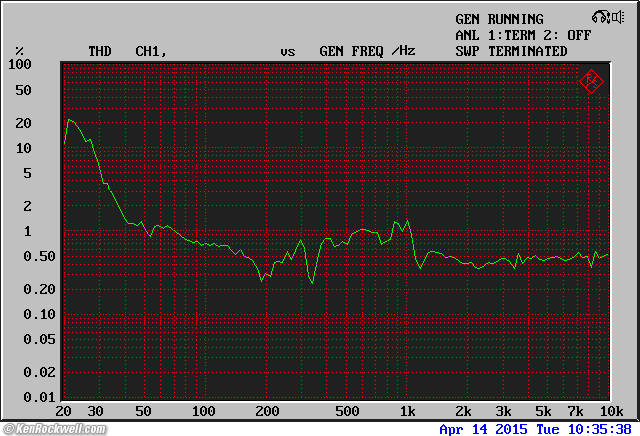
Focal CMS 65 THD at 90 dB SPL at 1 meter.
This is reasonable distortion at most frequencies, however the lack of bass distortion is superb. At 40 Hz, it's only 1% at 90 dB SPL, which is the same as a B&W ASW 850 subwoofer. Of course the subwoofer goes far deeper while this speaker's distortion increases below 40 Hz, but this does confirm my ear's observation that the low bass range of these speakers is unusually free from distortion.
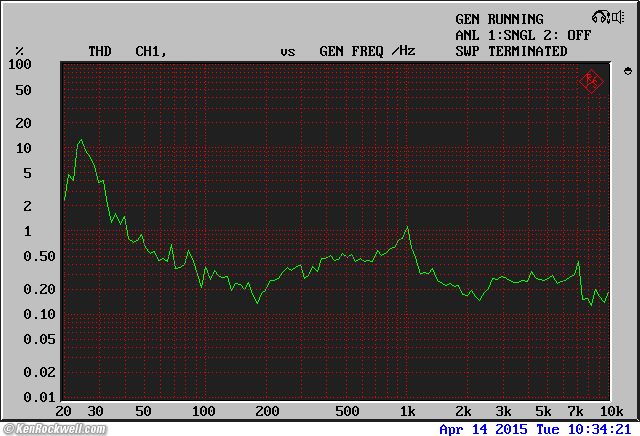
Focal CMS 65 THD at 80 dB SPL at 1 meter.
The distortion rise at 1 kHz confirms my suspicion that some internal reflection is making the response dip at 1 kHz. The harmonics stay at the same level making their percentage grow as seen on the graph.
Most of the distortion is second order:
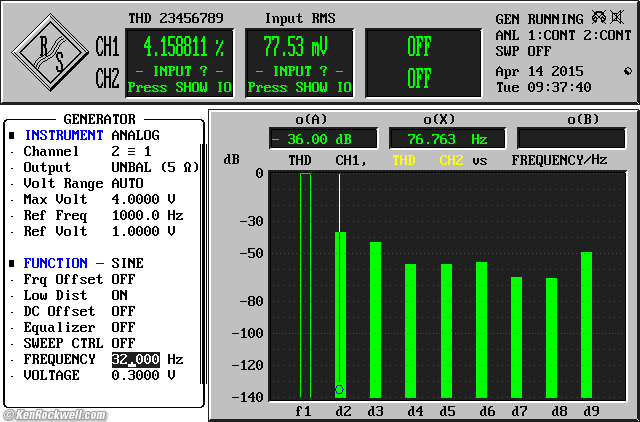
Focal CMS 65 Distortion Components at 32 Hz at 90 dB nominal SPL.
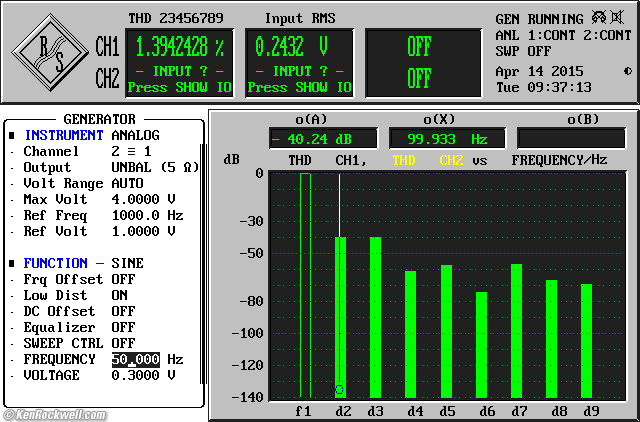
Focal CMS 65 Distortion Components at 50 Hz at 90 dB SPL.
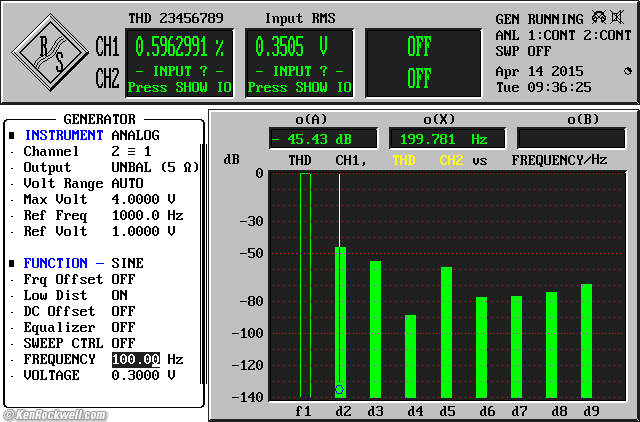
Focal CMS 65 Distortion Components at 100 Hz at 90 dB SPL.
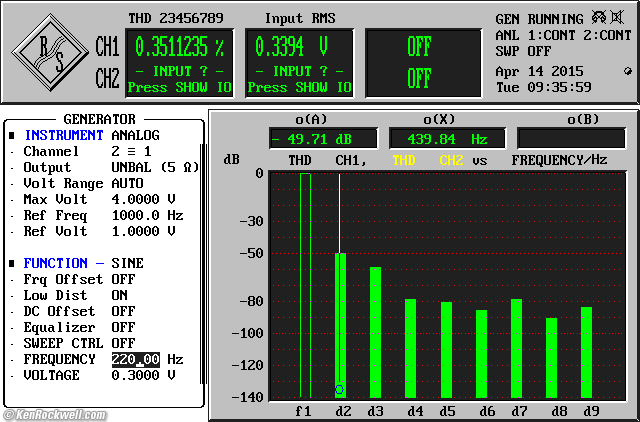
Focal CMS 65 Distortion Components at A = 220 Hz at 90 dB SPL.
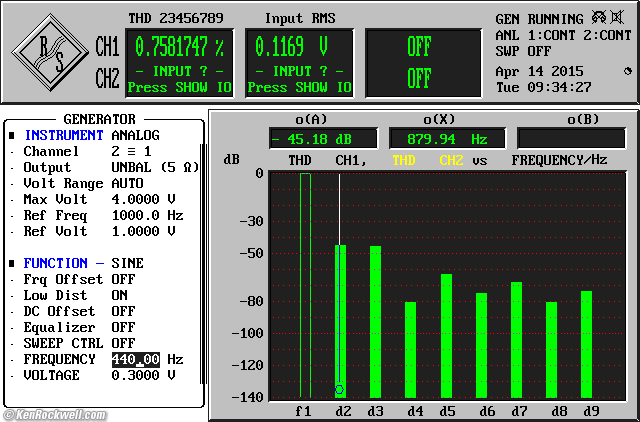
Focal CMS 65 Distortion Components at A = 440 Hz at 90 dB SPL.
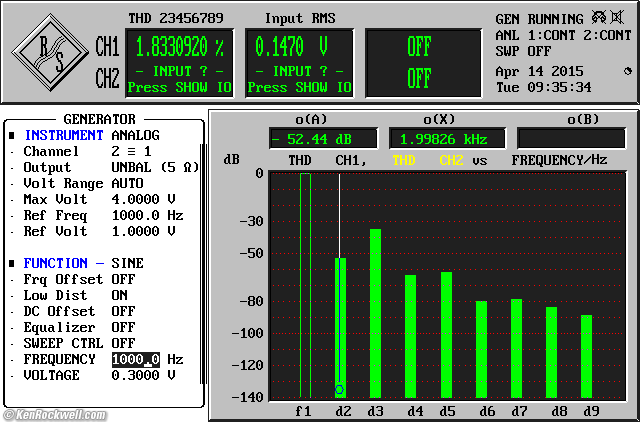
Focal CMS 65 Distortion Components at 1 kHz at 90 dB SPL.
The distortion is mostly third harmonic at 1 kHz, but this is more an artifact of the cancellations of the fundamental and presumably 2nd harmonic due to internal reflections.
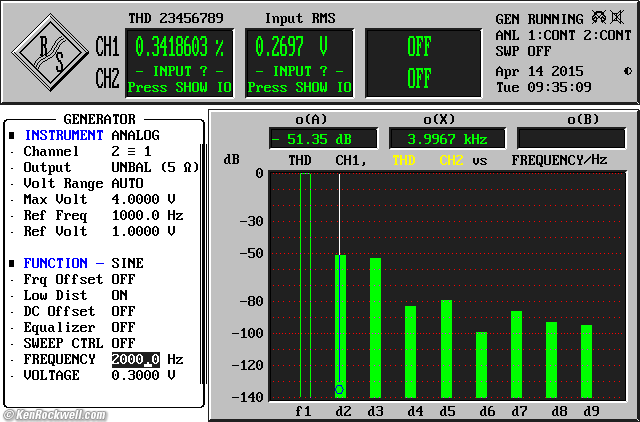
Focal CMS 65 Distortion Components at 2 kHz at 90 dB SPL.
Tone Bursts
Tone burst (transient) response is superb. It's nearly impossible to get acoustic waveform fidelity like this for tone bursts of 5 (at 100 Hz) or 10 cycles (other frequencies):
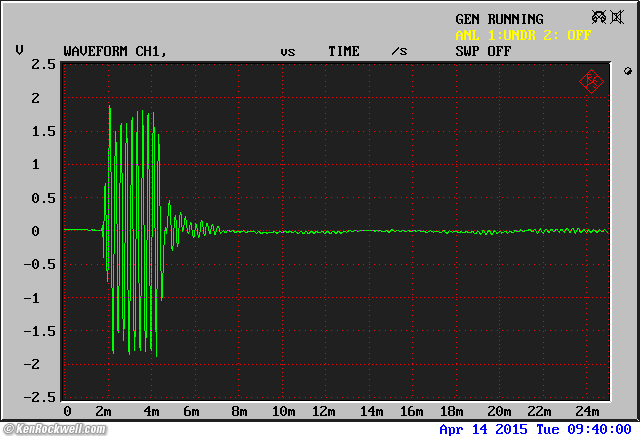
Focal CMS 65 Tone Burst at 4,000 Hz.
Beautiful!
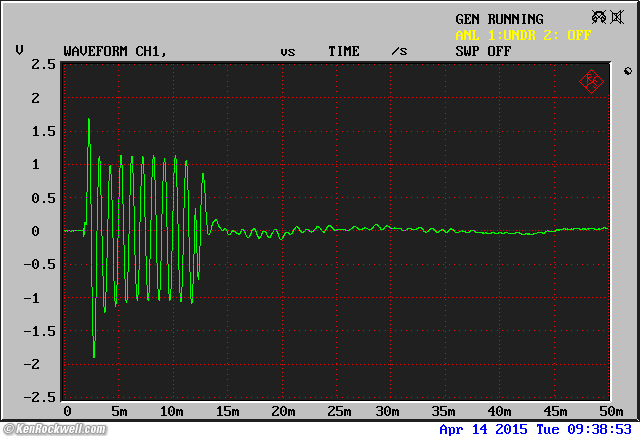
Focal CMS 65 Tone Burst at 1,000 Hz.
Ignore the low-frequency wiggling; that's rumble in my test area.
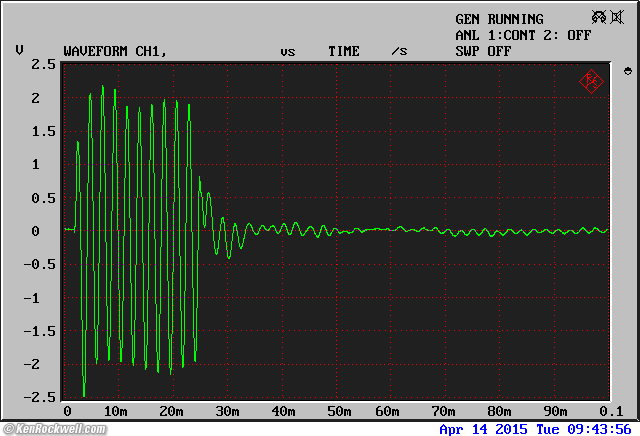
Focal CMS 65 Tone Burst at = 440 Hz.
I'd also ignore the slight returns beyond 30 mS; that's got to be reflections from something 15 feet away or more in my test environment.
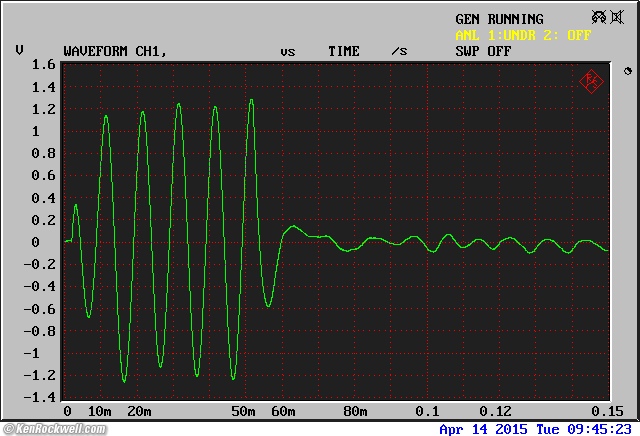
Focal CMS 65 Tone Burst at 100 Hz.
I'd also not worry about the return around 120 mS, which again is probably more likely an echo from something 60 feet away than anything in the speaker.
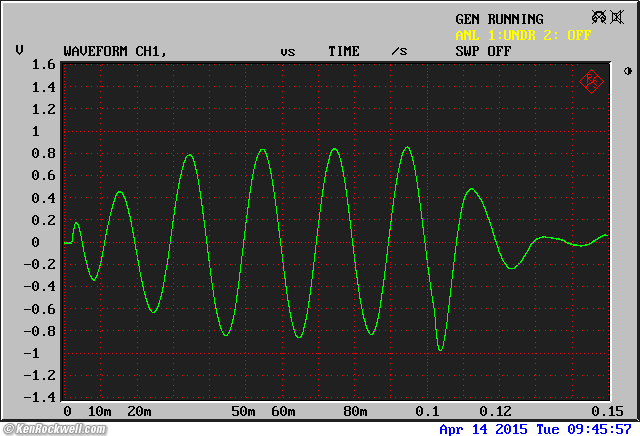
Focal CMS 65 Tone Burst at 50 Hz.
I measured a maximum of 1,000 µT, which was at the front grille.
This is a strong field, so be careful around your tapes and CRTs.
For normal use, no problem since few people are using CRTs or magnetic tape.
These get a little warm at the top of the back, and that's it.
Measured power consumption, per speaker:
11.9 W idle.
15W playing moderately loudly.
Usage top
Intro Specs Sound Measurements Usage Recommendations More
Setup
Focal says burn them in for a day or two. I lock them in a closet playing pink noise, and let people know I'm doing it so they don't fear we have a leak!
These are shipped with the level controls all the way down (pointed left at the LED).
The level controls are continuous pots with 11 clicks. They seem to track well enough so that I can set each to the same click to optimize my levels.
I drive these from my Benchmark DAC1 HDR's variable balanced outputs via a pair of XLR cables.
EQ Setting
Setting the 160 Hz notch to -4 dB sounds best on my glass top desk in my hardwood-panelled office.
Recommendations top
Intro Specs Sound Measurements Usage Recommendations More
Be sure to get two for stereo; these are sold singly and arrives as two big boxes. Of course buy as many as you need for multi-channel.
The bass response is nice as-is, and is easy to fortify with external EQ, but for professional monitoring where you need to hear subsonic rumble and defects before your client does, you'll still need subwoofers. For enjoying music, it's impressive how a little external EQ can jam all the bass you need through these monitors.
These are great monitors to get for your own studio, office or home. They work well to let us hear what we're doing, and also sound great for enjoying music when we're not making it.
These are best for use in your own facility. They have tough cases, and with their grilles are reasonably resistant to others fiddling with them, but they sound good enough that employees or students might be tempted to "borrow" them if used in a shared studio.
If I was installing these in a studio used by others, I'd go for something like the Neumann KH 120 because the KH 120 grills cannot come off, and the Neumann are even more accurate and unforgiving to get the job done. Most importantly, the Neumann don't sound good enough for enjoying music that people are going to want to steal them as they will with these Focal.
Accurate, calibrated speakers are just as critical to your audio as your picture monitor is to your video or still images. These speakers should last far longer than a picture monitor at about the same price. Once you've invested in a superb pair of professional monitor speakers, they should last for decades. Just like a picture monitor, if you don't have an accurate picture of your audio, you can't optimize it for the best sound.
If you find my work here helpful, my biggest source of support for this all-content, junk-free website is when you use any of these links to get them at B&H, as well as at Amazon. When you use those or any of these links to approved sources when you get anything, regardless of the country in which you live, it helps me keep adding to this free website — but I receive nothing for these efforts if you take the chance of buying elsewhere.
Thanks!
Ken.
More Information top
Intro Specs Sound Measurements Usage Recommendations More
Focal's CMS series user's manual
Help me help you top
I support my growing family through this website, as crazy as it might seem.
The biggest help is when you use any of these links to approved sources when you get anything, regardless of the country in which you live. It costs you nothing, and is this site's, and thus my family's, biggest source of support. These places have the best prices and service, which is why I've used them since before this website existed. I recommend them all personally.
If you find this page as helpful as a book you might have had to buy or a workshop you may have had to take, feel free to help me continue helping everyone.
If you've gotten your gear through one of my links or helped otherwise, you're family. It's great people like you who allow me to keep adding to this site full-time. Thanks!
If you haven't helped yet, please do, and consider helping me with a gift of $5.00.
As this page is copyrighted and formally registered, it is unlawful to make copies, especially in the form of printouts for personal use. If you wish to make a printout for personal use, you are granted one-time permission only if you PayPal me $5.00 per printout or part thereof. Thank you!
Thanks for reading!
Mr. & Mrs. Ken Rockwell, Ryan and Katie.
Home Donate New Search Gallery Reviews How-To Books Links Workshops About Contact

